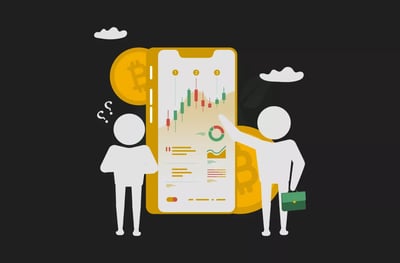Table Of Contents
- What is Copy Trading?
- The Difference Between Mirror Trading and Copy Trading
- The Difference Between Social Trading and Copy Trading
- Pros and Cons of Copy Trading
- Pros
- Cons
- How to Copy Trade in Practice
- What You Need in A Copy Trading Platform
- What Are Some of the Best Copy Trading Platforms?
- The Bottom Line
Copy Trading Explained
The act of trading in financial instruments can be daunting for new traders. It takes a long time to understand the terms and rules of the market, and all this inevitably comes with risk. As a new trader, you will learn one inescapable truth: that trading takes a serious investment in time, not only money.
However, not all people have enough time to devote to mastering trading strategies. Many of these traders have the capital and the willingness to trade, but need some guidance. This is where copy trading enters. Copy trading is the act of duplicating the trades of more experienced investors so you can enjoy the same winnings as them without putting any thought behind the trade. In this article, we will discuss copy trading in all its forms so you can understand how it works.
Copy trading lets you automatically replicate another trader’s positions
Followers maintain control by setting allocation levels, risk limits, or stopping replication at any time even while trades remain automated.
The process combines automation with social networking, delivering real‑time transparency into strategies, performance, frequency, and risk profiles of copied traders.
Providers earn income through performance fees, subscription plans, follower commissions, or profit-sharing based on assets under copy.
Copy trading is accessible via brokerage platforms integrated with social features
Key risks include over-reliance on others, misleading past returns, technical failures, hidden fees, emotional decisions, and sudden market swings.
New users should vet traders by comparing historical consistency, risk scoring, strategy style, and follower reviews before trusting their capital.
Best practices include starting with small amounts, diversifying across multiple providers, using demo accounts, setting stop‑loss thresholds, choosing regulated platforms, and monitoring performance routinely.
What is Copy Trading?
Copy trading allows newbie traders to take an active part in financial markets by giving them a chance to copy the trades of more experienced traders. This type of trading is perfect for new traders who want to experience the thrill of trading, but do not yet have the experience or know-how to do it on their own. Copy trading is the simple act of delegating your trading choices to expert traders using your capital. You can use copy trading in many markets, with FOREX and crypto being two of the most prominent ones.
Copy trading allows you to take advantage of another trader’s hard-won knowledge. By copying another trader via their signals, you can profit from their skills. You don’t even need deep knowledge of the financial markets to succeed. The name copy trading tells you everything you need to know about how it works. You decide how much you want to invest and, using your broker's copy trading facilities, you automatically replicate everything your chosen trader does. The best part is that you get identical returns on each trade as your chosen trader.

The Difference Between Mirror Trading and Copy Trading
The Difference Between Social Trading and Copy Trading
You may also have heard of social trading. This term is sometimes used interchangeably with copy trading, but it is not the same thing. With social trading, you do not engage in the act of copying trades so much as you engage in a meeting of minds with other traders like yourself. Using online spaces created by your broker, or a trading website like Arincen, you can meet with like-minded traders to exchange ideas on its network.
As you can see, social trading does not include any trading per se. You simply join a platform of people just like you to exchange knowledge and research ideas. If you get anything valuable from this process, you still have to execute your trades manually. It is not the time-saving exercise that copy trading or mirror trading can be.
Pros and Cons of Copy Trading
Pros
Skin in the game
Copy trading offers an accessible route to trading. You can get skin in the game. It is now easier than ever to get involved in trading through rapid advances in the technology behind trading platforms and algorithms.
Emotionless trading
Trading on emotion has tripped up many traders. The most successful traders have a rock-solid strategy that can be deployed consistently over time. By removing emotions from your investment journey, copy trading makes erratic decision-making, an inevitable by-product of human psychology, a thing of the past.
Improve your trading knowledge
With copy trading, you can learn from watching the moves of more experienced traders. Very few copy traders pay zero attention to the trades they are following. Many traders keenly watch the experts so that they can learn from them.
Locate other traders
On many platforms, finding traders to copy is simply a matter of filtering through different trading markers on their platforms, such as trading successes, profit and loss, the average size of winning and losing trades, reward-to-risk ratios, and more. It has never been easier to find other traders.
Diversification
With copy trading, you can split your portfolio across different assets. While you can make good profits on individual products, the rate and amount of profits vary widely. The relative risk attached to each instrument also varies. Copy trading allows you to invest in what you want up to a level with which you are comfortable. This diversification will naturally curb your risk exposure as the degree and type of risk are spread out.
Find free time
The natural result of automating your trades is freeing you up to do other things. You can focus on other interests during a trading session as someone you have selected is monitoring your trades. As great as this sounds, you are still encouraged to periodically review the performance of your chosen traders.
Cons
Market risk
The primary disadvantage of copy trading is that your trading performance is totally dependent on the trading results of the traders you follow. The market risk of trading this way means you can lose money if your chosen trader has bought and sold badly.
Choosing the right trader
Finding a reliable trader whose trades you can copy for the long term can sometimes be difficult. You need to do your own research to make sure you understand your chosen traders. That said, with so much choice in the market, you can keep trying until you find the perfect trader for you.
Execution and liquidity risk
Sometimes, you can attempt to execute a trade and find the market is illiquid. You may not be able to easily exit positions you hold. You don’t have any influence on the trades your chosen trader will open, meaning you will have to face some liquidity risk that may impact your ability to execute trades.
Systematic risk
Systematic risk refers to the volatility of an entire market that cannot be reduced or managed through diversification. For example, if you were to trade crypto but try to diversify your exposure by investing in many different coins, you would still be affected by the systemic risk that sometimes sees the entire crypto market in danger.
Recommended Brokers
How to Copy Trade in Practice
When you have completed your research on copy trading and are ready to start the real thing, there are a few important steps to take.
Choose a broker
Start by selecting a broker whose platform you like and that can support what you want to achieve as a copy trader. We will provide more details later in this article on what makes a good copy trading platform.
Select the right account
Many platforms are linked to different types of accounts that come with their own pros and cons. You will need to decide which account is best for you.
Select your trader
Using your broker’s filtering tools, you can select the trader whose approach best suits what you are trying to achieve. What is important to you as a trader? You could filter your search by items such as profitability, risk level, return on investment and fund size.
Decide how much to invest
Next, you will need to decide how much you want to invest. Remember that you can choose more than one trader to follow, so you may want to allocate more funds to certain traders. Once you input that information, the platform will automatically copy all your chosen trader’s positions into your account. Bear in mind that, with most brokers, you will need to maintain separate investment accounts for each trader you follow.
What You Need in A Copy Trading Platform
Most platforms come with three levels of copy trading functionality:
Automated: This full-service offering allows you to choose the traders and the trading strategies that best suit your risk profile, after which all positions and trades are replicated automatically, and hassle-free!
Semi-automated: With this type of trading, you can assess all your chosen trader’s positions before deciding to copy and trade yourself.
Manual: This form of trading looks most like regular trading in that you decide who to follow and which trades to copy, with the caveat that you give explicit permission before each trade is executed.
What Are Some of the Best Copy Trading Platforms?
In general, you should be looking for a broker who offers copy trading platforms that are well-regarded in the market. You should be able to use them on a personal computer, mobile or tablet so that you can trade at your convenience. Some of the best copy-trading brokers put the trader first and offer trader-centric solutions. Some well-known brokers in this regard include:
As far as Arincen goes, we may not be a broker, but we are a social networking platform that brings together traders and experts to exchange expertise and ideas. Our platform allows you to create your own private portfolio of traders and experts and follow their recommendations and investment sentiments. Further, you can keep an eye on market-price developments and the latest news. We have gone to extensive lengths to create an enabling environment where traders of all backgrounds can take part in a vibrant trading space.
The Bottom Line
FAQ
Normally, brokers do not charge special fees to use the copy trading function. You will, however, need to part with a portion of your winnings to pay the investment manager that most brokers allocate to each copy trader like you.
No. You do not need any prior experience. This is exactly the point of copy trading. You can choose to follow and copy other traders with no more input than choosing who to follow. That said, you are advised to check in on your trader’s performance periodically to make sure they are giving you the best returns.
All trading is risky. However, if you use discretion in identifying good traders, you are likely reducing the risk of trading on your own since you are copying seasoned traders with provable track records of success.
Yes, copy trading is legal in most countries where retail financial trading is popular.
Start by looking for traders who have long track records. If a trader can be successful over many years, even if their returns seem low (10%-25%), this shows they are trading conservatively and successfully. It may be tempting to copy the trades of a rock-star trader with annual returns such as 200-300%, but this is probably the result of a hot streak that will inevitably cool.
Copy trading is ideal for traders who don’t have the time to trade on their own and who don’t yet have the experience required to be successful. It is also ideal for beginners, as it allows them to learn the best trading practices along the way.
Your winnings depend on how well the traders you follow are performing. Some traders make profits under 30% and are satisfied with that. Other traders make three-figure profit percentages, but are most likely taking on more risk. You need to decide which trader and trading strategy is best for you.
If you are following a trader who has a long-term track record of profitable trades, you can be just as successful as them. In copy trading, your trading results fully depend on the trading performance of the investor whose trades you are copying.






